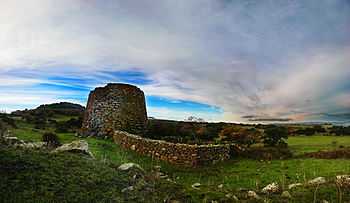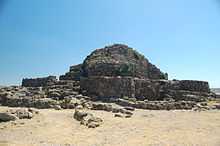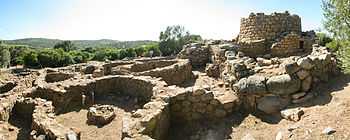Nuraghe




The nuraghe [nuˈraɡe] (plural Italian nuraghi, Sardinian Logudorese nuraghes / Sardinian Campidanese nuraxis) is the main type of ancient megalithic edifice found in Sardinia, developed during the Nuragic Age between 1900 and 730 BCE.[1] Today it has come to be the symbol of Sardinia and its distinctive culture, the Nuragic civilization.
Etymology
According to the Oxford English Dictionary the etymology is "uncertain and disputed": "The word is perhaps related to the Sardinian place names Nurra, Nurri, Nurru, and to Sardinian nurra 'heap of stones, cavity in earth' (although these senses are difficult to reconcile). A connection with the Semitic base of Arabic nūr 'light, fire, etc.' is now generally rejected."[2] The Latin word murus ('wall') may be related to it,[3] as the old Italian word mora ('tombal rock mound'), as used by Dante in his Comedy. However, the derivation: murus–*muraghe–nuraghe is debated.
General layout
The typical nuraghe is situated in areas where previous prehistoric Sardinian cultures had been distributed, that is not far from alluvial plains (though few nuraghi appear in plains nowadays, as they were destroyed by human activities such as agriculture, dams and others) and has the shape of a truncated conical tower resembling a medieval tower (outside) or a beehive (inside). The structure's walls consist of three components: an outer layer shaped like a tower (tilted inwards and made of many layers of stones whose size diminishes with height: mostly, lower layers consist of rubble masonry, while upper layers tend to ashlar masonry), an inner layer, made of smaller stones (to form a bullet shaped dome called "tholos", and where ashlar masonry is used more frequently), and an intermediate layer of very small pieces and dirt, which makes the whole construction very sturdy: it stands only by virtue of the weight of its stones, which may each amount to several tons. Some nuraghes are about 20 metres (60 ft) in height. A spiral stone stair was built within the thick walls, leading to upper floors (if present) and/or to a terrace.
Today, there are fewer than 7,000 nuraghes still existing in Sardinia, although their number was originally larger. Nuraghes are most prevalent in the northwest and south-central parts of the island.[4]
Cultural significance
There is a similar type of structure which has a corridor or a system of corridors. Some authors consider them somewhat older than the typical nuraghe and probably serving different purposes. The nuraghes were built between the middle of the Bronze Age (18th-15th centuries BCE) and the Late Bronze Age. This clearly rules out any possible cultural correlation with later towers such as Scottish Brochs (dating mainly to the 1st centuries BCE and CE). The claim that the El-Ahwat structures from Israel might be related is strongly contested; those are dated to either the 12th or the 11th century BCE. The only buildings widely accepted as being related to nuraghes are the torri (plural of torre) from Corsica.
According to Massimo Pallottino, a scholar of Sardinian prehistory and an etruscologist, the architecture produced by the Nuragic civilization was the most advanced of any in the western Mediterranean during this epoch, including those in the regions of Magna Graecia.[5] Of the 7,000 extant nuraghes, only a few have been scientifically excavated. Many Nuragic cultural traits and values were inherited by the Etruscans and by the Romans.
Function

There is no consensus on the function of the nuraghes: they could have been religious temples, ordinary dwellings, rulers' residences, military strongholds, meeting halls, or a combination of the former. Some of the nuraghes are, however, located in strategic places – such as hills– from which important passages could be easily controlled. They might have been something between a "status symbol" and a "passive defence" building, meant to be a deterrent for possible enemies.
Nuraghes could also have been the "national" symbol of the Nuragic peoples. Small-scale models of nuraghe have often been excavated at religious sites (e.g. in the "maze" temple at the Su Romanzesu site near Bitti in central Sardinia). Nuraghes may have just connoted wealth or power, or they may have been an indication that a site had its owners. Recent unconfirmed theories tend to suggest that Sardinian towns were independent entities (such as the city-states, although in a geographical sense they were not cities) that formed federations and that the building of these monuments might have depended on agreed-on distributions of territory among federated unities.
In 2002, Juan Belmonte and Mauro Zedda measured the entrance orientations (declinations and azimuths) of 272 simple nuraghes and of the central towers of 180 complex ones. The data revealed clear peaks corresponding to orientations pointing to the sunrise at winter solstice and to the Moon at its southernmost rising position. These alignments remained constant throughout the history of nuraghe.[6] The most common declinations revealed were of around −43° for the earlier nuraghes, shifting to just −45½° for the later. Zedda has suggested that the target is likely a star, quite possibly Alpha Centauri.[7]

Notable nuraghes
Nuraghes are inscribed on the UNESCO World Heritage Site list. Su Nuraxi di Barumini, in the south of the island, has been chosen to represent all the nuragic patrimony, but one of the highest and most complex Nuraghes is the Nuraghe Santu Antine near the village of Torralba, in northern Sardinia. Other famous nuraghi are near Alghero (Palmavera), Macomer, Abbasanta (see Losa), Orroli (Nuraghe Arrubiu), and Villanovaforru.
See also
- Ahwat
- Beehive tomb
- Broch
- Giants' grave
- Motillas (Iberian Nuraghe-like fortresses of La Mancha)
- Nuragic civilization
- Talaiot
Notes
- ↑ Depalmas, A. and R. T. Melis, "The Nuragic People: their settlements, economic activities and use of the land, Sardinia, Italy." In Landscapes and Societies: Selected Cases, Eds. Martini, I. P. and W. Chesworth. Springer Science+Business Media, New York: 2010.
- ↑ Oxford English Dictionary (online ed.), s.v. nuraghe.
- ↑ M. Pittau, philologist
- ↑ Encyclopædia Britannica, "Italy."
- ↑ Massimo Pallottino, La Sardegna Nuragica (Edizioni del Gremio, 1950).
- ↑ On the orientations of Sardinian nuraghes: some clues to their interpretation Authors: Zedda, M. & Belmonte, J. A. Journal: Journal for the History of Astronomy (ISSN 0021-8286), Vol. 35, Part 1, No. 118, pg 92 (2004) http://articles.adsabs.harvard.edu/cgi-bin/nph-iarticle_query?bibcode=2004JHA....35...85Z&db_key=AST&page_ind=14&plate_select=NO&data_type=GIF&type=SCREEN_GIF&classic=YES
- ↑ On the orientations of Sardinian nuraghes: some clues to their interpretation Authors: Zedda, M. & Belmonte, J. A. Journal: Journal for the History of Astronomy (ISSN 0021-8286), Vol. 35, Part 1, No. 118, pp.98-100 (2004) http://articles.adsabs.harvard.edu/cgi-bin/nph-iarticle_query?bibcode=2004JHA....35...85Z&db_key=AST&page_ind=15&plate_select=NO&data_type=GIF&type=SCREEN_GIF&classic=YES
References
- Dyson Stephen L., Rowland Robert J. (2007). Shepherds, sailors, & conquerors - Archeology and History in Sardinia from the Stone Age to the Middle Ages. Philadelphia: University of Pennsylvania, Museum of Archeology and Anthropology. ISBN 978-1-934536-02-5.
External links
| Wikimedia Commons has media related to Nuraghe. |
